iBuyPower Element Gaming PC Review: i7-8086K and GTX 1080 Ti Inside
by Joe Shields on July 6, 2018 10:00 AM ESTGaming Performance 2018: AoTS Escalation, ROTR, Civ 6, Shadow of Mordor, and GTA V
The testing seen below will be a mish-mash of results designed to get readers a good idea of the general gaming performance of the iBuyPower system as configured from the factory. In this case, the system is configured with an i7-8086K running at 5 GHz all cores/threads along with a reference NVIDIA GTX 1080 Ti. Depending on the benchmark, we have put this system up against our motherboard review system consisting of a stock i7-8700K and a GTX 980 for AoTS:E and ROTR as well as that same system running a 1080 Ti for comparison. The rest of the data sets were sourced from a CPU review covering several modern AMD and Intel-based CPUs while using a GTX 1080. So while we do not have any direct comparisons to the Element, the data gathered here will show a good idea of overall performance in our testing with how this system is set up compared to others.
Ashes of the Singularity
Ashes of the Singularity is a Real Time Strategy game developed by Oxide Games and Stardock Entertainment. The original AoTS was released back in March of 2016 while the standalone expansion pack, Escalation, was released in November of 2016 adding more structures, maps, and units. We use this specific benchmark as it relies on both a good GPU as well as on the CPU in order to get the most frames per second. This balance is able to better display any system differences in gaming as opposed to a more GPU heavy title where the CPU and system don't matter quite as much. We use the default "Crazy" in-game settings using the DX11 rendering path in both 1080p and 4K UHD resolutions. The benchmark is run four times and the results averaged then plugged into the graph.
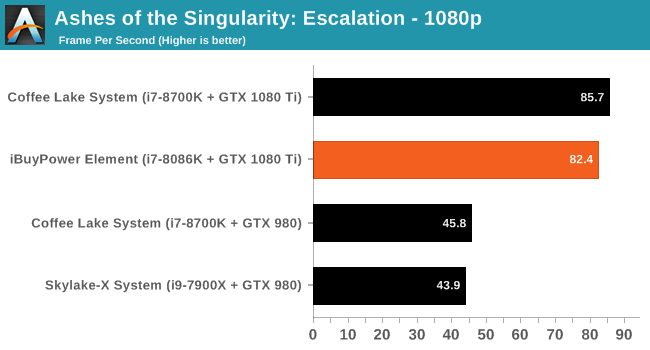
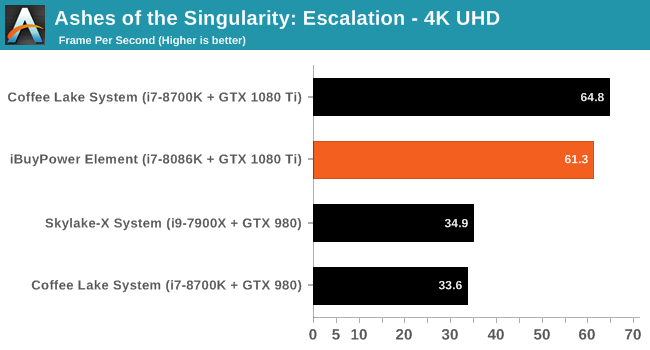
Our AOTSe results show the iBuyPower system managing 82.4 FPS at 1080p and 61.3 FPS when running 4K UHD. We can see the stock i7-8700K system managing a few more FPS, and this is likely due to how our OS is setup including the HPET timer, and other variables between systems.
Rise of the Tomb Raider
Rise of the Tomb Raider is a third-person action-adventure game that features similar gameplay found in 2013's Tomb Raider. Players control Lara Croft through various environments, battling enemies, and completing puzzle platforming sections, while using improvised weapons and gadgets in order to progress through the story.
One of the unique aspects of this benchmark is that it’s actually the average of 3 sub-benchmarks that fly through different environments, which keeps the benchmark from being too weighted towards a GPU’s performance characteristics under any one scene.
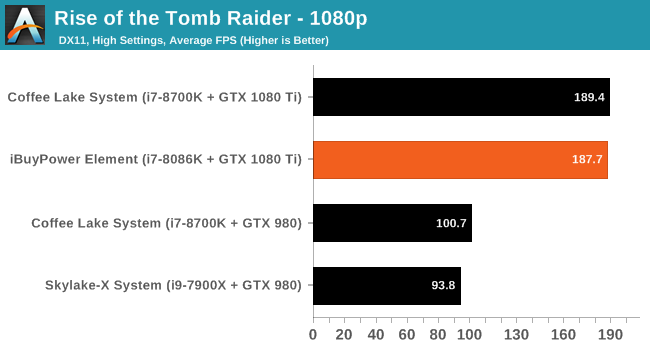

Rise of the Tomb Raider results show the iBuyPower system reaching 187.7 FPS in 1080p and 83.8 FPS in 4K. This compares well with the other 1080 Ti tests as they are close enough to be within the margin of error, especially given how GPU-bound this game is at these settings.
Civilization VI
For a look at a more CPU-bound gaming workload, we have Civilization 6. Originally penned by Sid Meier and his team, the Civ series of turn-based strategy games are a cult classic, and many an excuse for an all-nighter trying to get Gandhi to declare war on you due to an integer overflow. Truth be told I never actually played the first version, but every edition from the second to the sixth, including the fourth as voiced by the late Leonard Nimoy, it a game that is easy to pick up, but hard to master.
Benchmarking Civilization has always been somewhat of an oxymoron – for a turn based strategy game, the frame rate is not necessarily the important thing here and even in the right mood, something as low as 5 frames per second can be enough. With Civilization 6 however, Firaxis went hardcore on visual fidelity, trying to pull you into the game. As a result, Civilization can taxing on graphics and CPUs as we crank up the details, especially in DirectX 12.
Perhaps a more poignant benchmark would be during the late game, when in the older versions of Civilization it could take 20 minutes to cycle around the AI players before the human regained control. The new version of Civilization has an integrated ‘AI Benchmark’, although it is not currently part of our benchmark portfolio yet, due to technical reasons which we are trying to solve. Instead, we run the graphics test, which provides an example of a mid-game setup at our settings.
At both 1920x1080 and 4K resolutions, we run the same settings. Civilization 6 has sliders for MSAA, Performance Impact and Memory Impact. The latter two refer to detail and texture size respectively and are rated between 0 (lowest) to 5 (extreme). We run our Civ6 benchmark in position four for performance (ultra) and 0 on memory, with MSAA set to 2x.
For reviews where we include 8K and 16K benchmarks (Civ6 allows us to benchmark extreme resolutions on any monitor) on our GTX 1080, we run the 8K tests similar to the 4K tests, but the 16K tests are set to the lowest option for Performance.
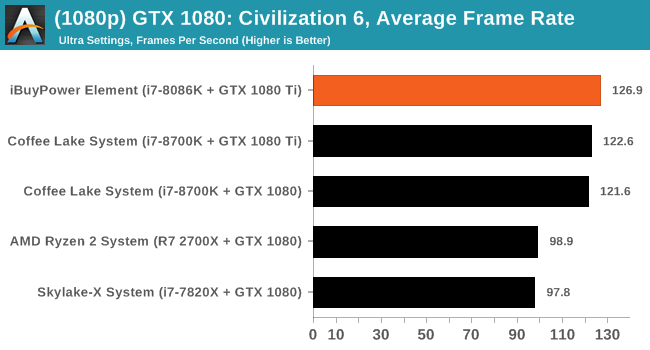
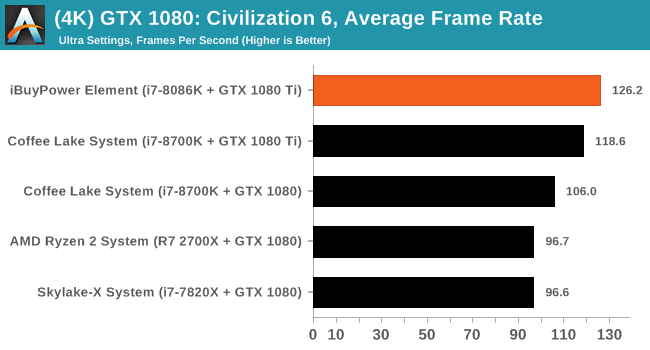
Moving on to Civ6, we have some interesting results here as we seem to be limited by the CPU at both 1080p and 4K resolutions achieving nearly the same results for each resolution. The FPS is seemingly capped by the CPU driving the GPU, even with a GTX 1080 and other, lesser CPUs in this test. We can see the higher clocked CPU in the iBuyPower PC manages to be a few FPS faster than the stock i7-8700K at each resolution.
Shadow of Mordor
The next title in our testing is a battle of system performance with the open world action-adventure title Middle Earth: Shadow of Mordor (SoM for short). Produced by Monolith and using the LithTech Jupiter EX engine and numerous detail add-ons, SoM goes for detail and complexity. The main story itself was written by the same writer as Red Dead Redemption, and it received Zero Punctuation’s Game of The Year in 2014.
A 2014 game is fairly old to be testing now, however SoM has a stable code and player base, and can still stress a PC down to the ones and zeroes. At the time, SoM was unique, offering a dynamic screen resolution setting allowing users to render at high resolutions that are then scaled down to the monitor. This form of natural oversampling was designed to let the user experience a truer vision of what the developers wanted, assuming you had the graphics hardware to power it but had a sub-4K monitor.
The title has an in-game benchmark, for which we run with an automated script implement the graphics settings, select the benchmark, and parse the frame-time output which is dumped on the drive. The graphics settings include standard options such as Graphical Quality, Lighting, Mesh, Motion Blur, Shadow Quality, Textures, Vegetation Range, Depth of Field, Transparency and Tessellation. There are standard presets as well.
We run the benchmark at 1080p and a native 4K, using our 4K monitors, at the Ultra preset. Results are averaged across four runs and we report the average frame rate, 99th percentile frame rate, and time under analysis.
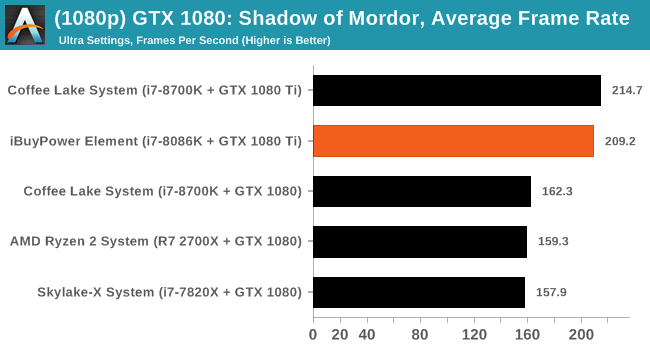

It doesn't take much to push high frame rates in Middle Earth: Shadow of Mordor, and the 1080 Ti on either systems breaking 200 FPS. The difference here at 1080p is around 5 FPS or a bit under 2.5% difference in favor of the AnandTech 1080 Ti system. When moving up to 4K resolution, the song remains the same as far as the result and approximate difference between the systems.
Grand Theft Auto
The highly anticipated iteration of the Grand Theft Auto franchise hit the shelves on April 14th 2015, with both AMD and NVIDIA in tow to help optimize the title. GTA doesn’t provide graphical presets, but opens up the options to users and extends the boundaries by pushing even the hardest systems to the limit using Rockstar’s Advanced Game Engine under DirectX 11. Whether the user is flying high in the mountains with long draw distances or dealing with assorted trash in the city, when cranked up to maximum it creates stunning visuals but hard work for both the CPU and the GPU.
For our test we have scripted a version of the in-game benchmark. The in-game benchmark consists of five scenarios: four short panning shots with varying lighting and weather effects, and a fifth action sequence that lasts around 90 seconds. We use only the final part of the benchmark, which combines a flight scene in a jet followed by an inner city drive-by through several intersections followed by ramming a tanker that explodes, causing other cars to explode as well. This is a mix of distance rendering followed by a detailed near-rendering action sequence, and the title thankfully spits out frame time data.
There are no presets for the graphics options on GTA, allowing the user to adjust options such as population density and distance scaling on sliders, but others such as texture/shadow/shader/water quality from Low to Very High. Other options include MSAA, soft shadows, post effects, shadow resolution and extended draw distance options. There is a handy option at the top which shows how much video memory the options are expected to consume, with obvious repercussions if a user requests more video memory than is present on the card (although there’s no obvious indication if you have a low end GPU with lots of GPU memory, like an R7 240 4GB).
To that end, we run the benchmark at 1920x1080 using an average of Very High on the settings, and also at 4K using High on most of them. We take the average results of four runs, reporting frame rate averages, 99th percentiles, and our time under analysis.
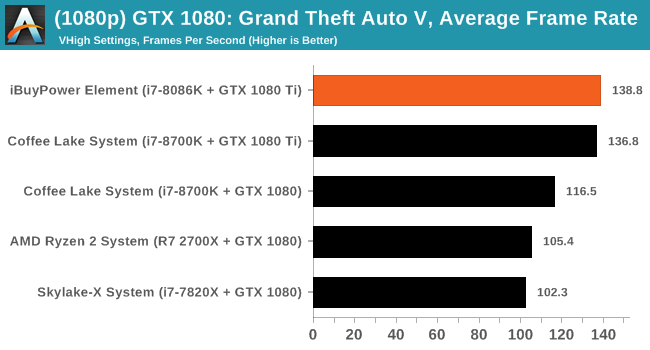
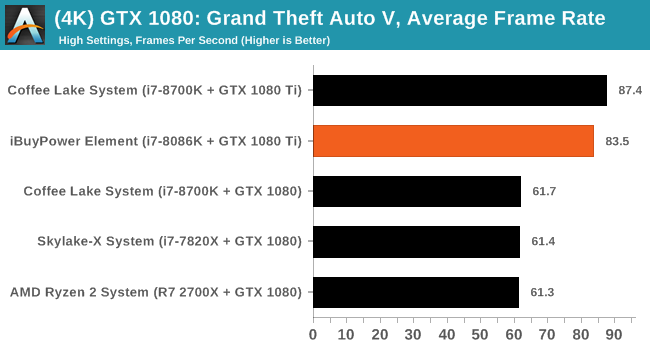
GTA V is a notoriously CPU heavy title at the lower resolutions and here we see the iBuyPower machine have about a 'run variance' size lead of 2 FPS (around 1.5%). A result we expected considering the similarities between the machines. The 4K results are a bit different with the Anandtech bench system around 4 FPS or ~5% quicker in this test.
Overall we have seen results a bit over the place. The problem we faced here is setting up the systems to be as close as possible but without degrading the integrity of the purchased system as that is how users will receive it out of the box. Surely some tweaking goes on, but for the most part if a user is buying a pre-built PC like this, most are not digging and tweaking OSs and memory timings, though that ability is there. In the end, the iBuyPower system fared well and was right around our reference system in all testing. Gaming temperatures were acceptable and we did not see any throttling in the iBuyPower system, but CPU temperatures when running AOTSe did hit 90C so the system is tapped out at its current settings. Clearly though, the i7-8086K (or i7-8700K) and 1080 Ti make a solid pair allowing users to get the most out of their graphics card and gaming experience.


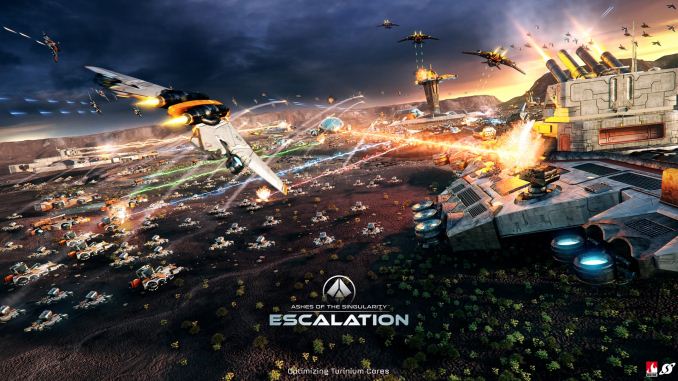
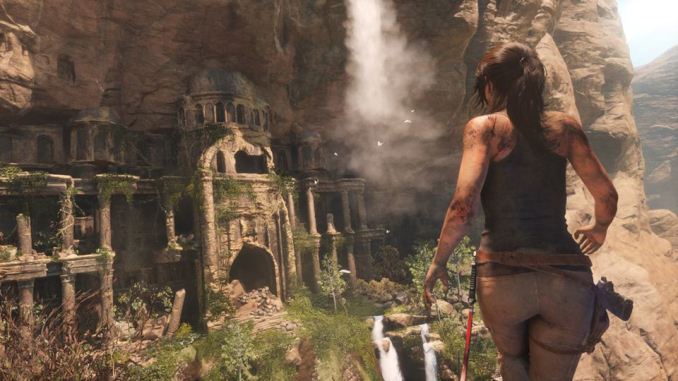
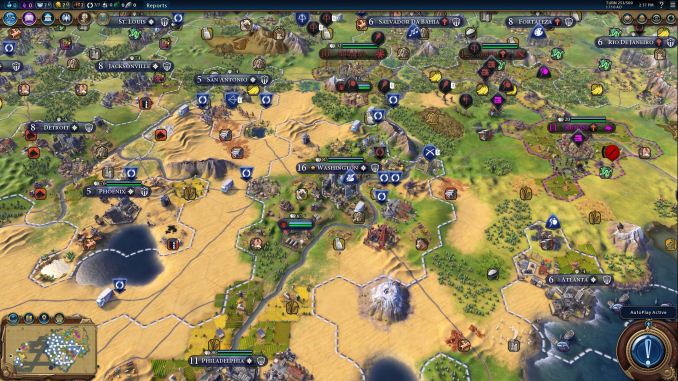

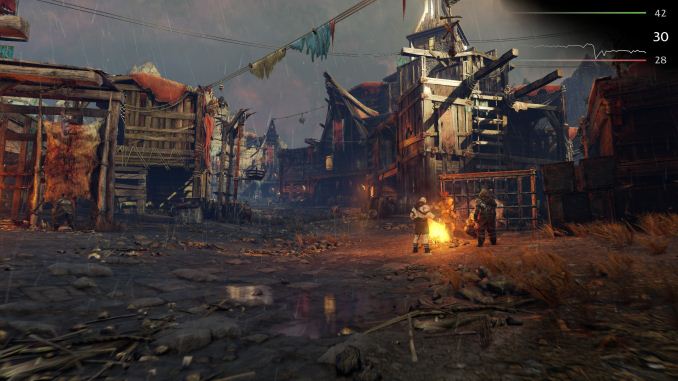
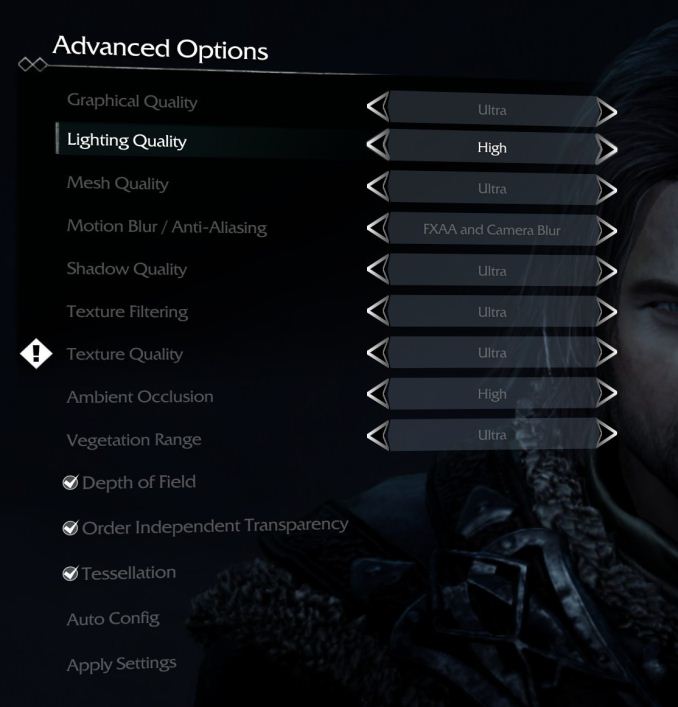

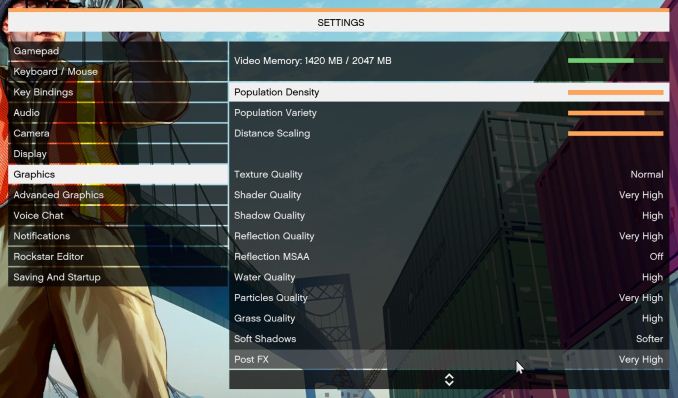








50 Comments
View All Comments
WasHopingForAnHonestReview - Saturday, July 7, 2018 - link
You complained about stock photos... Another whined about possiboe static electricity from foam packing. Another said he likes not having so many rbg lights. Lol get a clueNotmyusualid - Monday, July 9, 2018 - link
@ WasHopingForAnHonestReview- Thanks for saying out loud what was screaming inside of my head.
Go outside - the graphics are great!
just4U - Friday, July 6, 2018 - link
From the article: "So where does that leave us? As someone who has built PCs with my own hands for well over 20 years, it can be difficult to find a lot of value in any system builder."---
Like you I've been building systems for over 20 years now, and personally find it rewarding and your right it can be hard for people like that to find value in systems like this.. However I ran into a interesting problem this spring.
Building my own system would have cost me $275 more than buying a ibuypower or alienware computer. The parts would be better overall in the system if i built it myself but i couldn't get anything comparable due to high memory and video card costs. I eventually went with the Alienware as Im going to really look forward to tearing it down and rebuilding it in 4-5 years..whereas the Ibuypower is something more in line with what I'd build.. First time in a very long time I've actually purchased a (non laptop) system.. They have come a long way and certainly add value in the right areas these days.
lazarpandar - Friday, July 6, 2018 - link
I could build something that performs identically and is way less flashy for *way* less than $1950 estimated in the article.Hell eBay has been doing those 20% off sales like twice a month. Get your GPU one week and your CPU another, Newegg bundle whatever you can, check Slickdeals for SSDs, maybe put up with a rebate for your PSU. You could build this thing for like $1500.
Yvonne M. Miller - Saturday, July 7, 2018 - link
niceMDD1963 - Saturday, July 7, 2018 - link
Pleasantly surprised by this offering, actually; not everyone builds their own, and, $250 markup over all parts ordered individually is not a horrible deal, and, at least all parts seem 'brand name', although I'd sure skip the 8086K over a standard 8700K, refusing to pay another $150 for 200 more MHz or so....lazarpandar - Saturday, July 7, 2018 - link
It may be $250 markup on parts, but you have to also factor in which parts you wouldn't even include if you made the thing yourself. Like LEDs, closed loop cooler, you could get different parts that perform almost identically for way way less than $250 less. I'm sure that case is >$100 by itself, you can definitely good cases for cheaper. This doesn't even take into account the amount of savings you would see switching to AMD Ryzen 2 with probably a non-noticeable drop in frame rates.It's just a disingenuous claim that exists to make the value proposition of a prebuilt seem reasonable when in reality you can save way way way more than that.
P2C - Sunday, July 8, 2018 - link
It's disingenuous to say you could do it cheaper by switching or omitting parts when you could also modify the build from the system builder and come up with a comparable, cheaper system. The reality is if you need to build a system with these vendors using identical or near as possible components you would likely save less than 10% on a DIY. These companies will also include the necessary items to redeem manufacturer rebates. If you could wait for special deals you could save more but that's not always practical or convenient. Here's the system reviewed using PCPartpicker: https://pcpartpicker.com/list/HxQx9J with the only change being the case which is available at same price on Ibuypower. As of this post you save $134 on the DIY. Do the same for your build and the same at Ibuy or Cyberpower and show me the way way more savings.Arbie - Sunday, July 8, 2018 - link
@P2C - excellent comment; thanks for laying it out.lazarpandar - Sunday, July 8, 2018 - link
I would say that it's not disingenuous at all to state the following: You can get the same performance and save way way more than $250. I'm not talking about same parts, I'm talking same performance. I'm also talking about intelligently taking advantage of coupons and specials as they come up. Taking those points away from my argument is moving the goalposts a hell of a distance.If you watch eBay and Google Express for site-wide coupon codes, you can get your CPU and GPU at 15-25% discounts. You can check Slickdeals for the history of those coupons, they come up twice a month. EXTRA25 gets you 25% off Google Express orders (up to $100 savings) which include orders from Fry's *right now*.
No I'm not going to build some machine that adheres explicitly to the parts used on iBuyPower's website, that was never my point and would be a waste of my time. If you want to have the argument I'm trying to have, then go ahead and respond, but if you want to keep moving the goalposts, don't even bother.